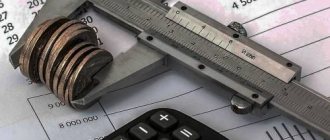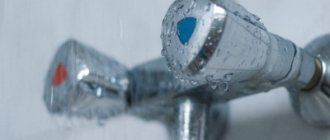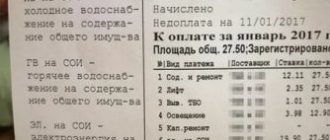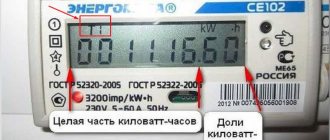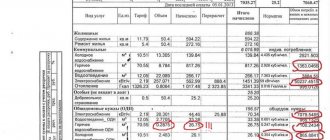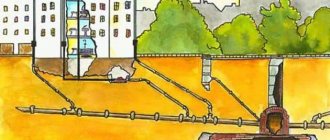What is sewerage in a housing and communal services receipt?
Are drainage and sewerage the same thing?
Government Decree No. 354 is a document that gives a clear explanation of the concept of wastewater disposal.
The document was released in 2011. The compilers indicate that the term includes a whole range of measures, the main goal of which is to free residential premises from domestic wastewater.
To resolve the issue, a special connecting network is used. The operation is available to all consumers of public utility resources.
Regulating direction and setting restrictions is a task for government authorities. References to a number of other regulatory documents are acceptable:
- Resolutions, recommendations from local governments.
- Local rules issued by the water utility and other structures related to wastewater disposal.
- Regional regulations, provisions. Based on them, the total amount to be paid is calculated.
- Government Resolutions that mention housing and communal services.
About cold water supply and hot water supply in receipts
Article 154 of the Housing Code of the Russian Federation is devoted to those public services for which all residents pay suppliers. This describes the right to use abbreviations and acronyms by management companies.
A ban is imposed on adjusting names and abbreviations. The main thing is to comply with current recommendations adopted at the legal level. Questions from users involve a large number of abbreviations.
The abbreviation HVS is used to denote cold water supply. DHW is hot. Sometimes receipts contain combinations such as HVS DPU.
This means that the readings of communal meters are the basis for charging consumption fees. The presence of the abbreviations HVS KPU assumes that the citizen has his own meter in his apartment. Its readings become the basis for any calculations.
Decoding the housing and communal services receipt 2021, how to understand the services and what is included in them
In situations where there is a civil lease, the rent is addressed directly to the landlord, and the tenant can actually pay it. These conditions must be specified in the contract. The reverse calculation procedure is also possible. UUTE in the receipt is responsible for the provision of thermal energy to apartments. It reflects how many resources were supplied and at what tariffs the payment is calculated. The inclusion of UTE occurs depending on the season. Decoding the abbreviation: u.
About wastewater disposal
Users often think that the word “sewage” only refers to services related to sewerage. They believe that this is only a description of a waste water drain. But the concept often includes additional directions:
- Wastewater disposal for technical purposes.
- Disposal of waste in liquid form.
- Purification of wastewater from waste and contaminants.
- Transfer of wastewater to treatment facilities.
- Discharge of used water, high and low temperature.
Drainage and water supply
A payment document with a new line “Wastewater disposal” began to be sent to all owners and tenants of premises since 2011.
Many payers mistakenly believe that this service consists solely of draining water from sanitary facilities (sink, bathtub, shower, etc.). In reality, wastewater disposal activities consist of several stages:
- First, water flows by gravity from buildings into the city sewer network;
- Places where gravity transportation is not possible are equipped with water pumping stations that facilitate further movement of wastewater through the water supply system. In the receiving chamber of the pumping station, water flows through mechanical screens that clean it of household and other debris;
- Collected waste from stations is transported to a landfill;
- Then the water flow enters purification engineering complexes and from there into natural reservoirs.
The process of drainage and purification of used water is aimed at preserving the environment and protecting groundwater and open natural reservoirs from pollution .
IMPORTANT! Treatment procedures for used water help improve the quality of the water supply.
Water supply, like drainage, passes through many stages.
Purification of natural water begins with the removal of solid debris mechanically. The second stage is treatment with reagents, chlorination. Then the water settles and undergoes membrane filtration, after which laboratory tests are carried out.
If the water quality meets the standard, it is transported to storage facilities, from where it is supplied to residents. To supply hot water, it is pre-heated.
Tariff and calculation for payment for services
When setting tariffs, various parameters are used. There is no so-called single tariff for all of Russia. The values differ for each region. These parameters will become the basis for calculations:
- Amount of remuneration for representatives of the water utility.
- Payment for the services of emergency crews. The services of specialists who maintain the operational state of networks are taken into account. Separate payment for water supply services.
- Number of consumer users. Those citizens who have separate meters are also taken into account.
- The quality of pumping stations, their location.
- The distance over which the wastewater is pumped, the liquid itself.
- The entire network is assessed for performance.
- Description of the current sewerage condition.
- Conditions of the region in terms of climate, weather.
Cold and hot water supply – Accrual Center
The purpose of creating special centers is to consider issues of water supply and consumption. Its employees are responsible for calculating water tariffs. They also control the collection of money.
By 2021, such associations will be formed in every major locality. Among the responsibilities of these institutions are the following:
- Interact with emergency services to dispatch to incident sites.
- Monitoring the state of the networks.
- Recalculation of payment documents in the event of disputes.
Who is charged with increasing coefficients?
— When preparing payment documents, the utility service provider determines the amount of payment for cold water supply, hot water supply, electricity supply and heat supply, taking into account increasing factors, which must be indicated on a separate line. That is, the utility service must be indicated independently, and separately - the line “the amount of payment for the utility service in the amount of the increasing coefficient,” explains Denis SEDOV, director of the Contact Center under the Mayor of Ulyanovsk.
The provisions of Part 1 of Article 157 of the Housing Code of the Russian Federation and Rules No. 354 establish that the amount of payment for utilities is calculated based on the volume of consumed utilities, determined by the readings of metering devices, and in their absence, based on the standards for the consumption of utilities. From the provisions of the current edition of Rules No. 306 and Rules No. 354 it follows that in the formulas for calculating the amount of payment for utility services for consumers who have not installed the appropriate metering device (if it is technically possible to install the metering device or in the absence of documentary evidence of the presence (absence) of the technical possibility of installation metering device), an “increased standard” must be applied.
27 Jun 2021 stopurist 714
Share this post
- Related Posts
- What benefits do large families have in 2021 in the Khanty-Mansi Autonomous Okrug?
- Allowances for non-working Military Pensioners for Children in 2020
- What documents are needed to receive a tax deduction for education?
- Documents for issuing a maternity capital certificate
Why is wastewater disposal greater than consumption?
Compared to wastewater disposal, liquid consumption often has increased tariffs. Many consumers have problems with this. This situation is due to several reasons:
- Special technologies for water purification that improve the system.
- Waste in liquid form requires high payment for disposal.
- Features of the region related to climate. Tariffs typically increase if the region experiences low temperatures. In this case, it is more difficult to maintain the working state of the networks.
Preparation with heating, transportation are new operations that often complement the drainage service. Because of this, costs increase, and standard rates are also higher.
Tariffs and formulas, calculation features
How is drainage calculated on the receipt? This formula will be the main one when calculating the total of payments:
SW = (CW + DHW) x TV.
- TV is an included tariff associated with the disposal of water or wastewater.
- DHW is high temperature water that has already been used.
- Cold water – consumed cold water.
- SV – the amount of payment for the sewerage service in general.
The Government Decree on the procedure for paying for utility services describes in detail the calculation rules, and additional recommendations are provided in the same document.
Utilities for ind consumption what is it
Calculation for personal account 041107429 is made based on the provided consumption from the common house heat energy meter. Consumption data is provided by the management organization. Consumption from the common house meter is taken from the 23rd to the 25th of each month. Accordingly, the June receipt shows the consumption from the common house meter for the period: from the date of the last reading in April to the day the heating was turned off in May. Please note that in accordance with Order No. 71 of 05/06/16. The Committee on Energy and Engineering Support ended the heating period in St. Petersburg on 05/06/16. Good afternoon In April, meter readings were not provided, so the receipt for May was calculated based on average consumption. Based on the testimony provided in the month of May, the June receipt shows an accrual for the share of the utility resource consumed in May according to metering devices and recalculation was made with an additional accrual for April, since the accrual for the average consumption was less than what was actually consumed.
21 Dec 2021 marketur 199
Share this post
- Related Posts
- Fled from the scene of the accident and did not notice the impact
- Who are children of war and their benefits?
- Power of attorney form with the right to receive funds
- Who pays benefits for utilities to disabled people in Tagil
How do they calculate if there is no meter?
In this case, all expenses are paid based on general consumption standards.
The disadvantage is that average standards are always higher compared to actual consumption volumes. Regulations are regulated by local authorities.
When calculating, parameters characteristic of a particular room are taken into account. After this, the standard in cubic meters is multiplied by the number of people living at a particular address. The numbers are also multiplied with the applicable tariff. After all checks have been completed by the Accrual Center, the receipt is filled in with the amounts received.
It is easy to find out what tariffs apply in a particular city from management companies and on the suppliers’ website.
Cold water supply in an apartment building
The volume (quantity) of cold water supply per residential premises (apartment) or non-residential premises provided during the billing period for common house needs in an apartment building that is not equipped with collective (common house) cold water supply metering devices is determined by formula 15:
consumption standard for cold water supply provided for the billing period for general house needs in an apartment building, established in accordance with the Rules for establishing and determining standards for the consumption of utility services, approved by Decree of the Government of the Russian Federation of May 23, 2006 N 306;
What to do when the amount is more than you need to pay?
Receipts from management companies often contain information about increased payments. Many people do not know that their rights have been violated. The reason is the lack of knowledge on calculating standards and tariffs. If the law is broken, we must fight it.
You can carry out the calculation yourself using two main methods:
- According to the standard.
- Based on metering devices.
The total in numbers is compared with the information from the receipt.
If there is an excess, recalculation involves sending applications to representatives of the management company. The number of copies of the application is two. One of them is supplemented with a note with the date of review. The compiler keeps the second copy for himself.
On average, it takes a month for applications to be considered. If time has passed and the answer has not arrived, the citizen has the right to file statements of claim with the courts. If the overpayment is revealed several months, and even more so years, the other party will be forced to reimburse the costs.
Claims submitted by an entire team are satisfied more often and faster.
Calculation of drainage
The procedure for calculating the amount to pay is simple - you need to sum up the used cold and hot water for the period, and then multiply the resulting figure by the tariff established for sewerage.
For example, with a tariff of 27 rubles 01 kopeck (this is exactly what has been established in Moscow since July 1, 2021) and water consumption of 7.5 cubic meters of cold and 4.3 cubic meters of hot water per month, the following will result:
27.01 x (7.5 + 4.3) = 318 rubles 72 kopecks will be the payment for sewerage.
But this is if you have a water meter. If it is absent, then consumption will be considered according to the standard and, accordingly, water disposal too. The standard varies by region, but is usually much higher than the meter readings. For example, in the previous example, consumption roughly corresponds to a family of three. Let’s now try to calculate how much the same family will have to pay according to the standard.
For Moscow, the consumption standard for 2021 is 5.48 cubic meters of cold and 3.81 cubic meters of hot water per person. You can calculate it as follows:
(5.48 + 3.81) x 3 = 27.87 cubic meters a family of three will use up in a month according to the standard, versus an average of 10-12 in reality. Accordingly, you will have to pay more for both water supply and sewerage - for the latter 27.87 x 27.07 = 752.77 rubles. The overpayment for just one sewerage system will be more than 400 rubles per month, which clearly encourages the installation of a meter.
In addition to a separate meter in a home, a common meter can also be installed for an apartment building: in this case, the standard will be calculated according to its indicator, which will significantly reduce it, but in any case, it is better to get a separate meter in the apartment.
The most effective would be a special wastewater flow meter, which will show the exact value of wastewater, as a result of which you will not have to use the readings of a regular meter to calculate payments for sewerage.
Is it possible to refuse to pay for sewerage?
The misconception of many is that sewerage does not have to be paid for. Because of such misconceptions, debts accumulate. It is necessary to fulfill such duties, otherwise penalties will be applied to the citizens themselves. Forced disconnection from the sewer system is unacceptable. The following measures are acceptable on the part of the state:
- Restrictions on traveling abroad.
- Appeal to the court.
Common measures include forced debt collection. There is a high probability that claims from the company will be satisfied. Valuing property to write off debts and using wages are standard steps in such situations.
- Accrual of penalties due to non-payment.
Usually it is applied until the 10th day of the month following the billing month. The debt increases as there are no transfers.
Is it possible to reduce the amount of payments?
For apartment buildings, payments for sewerage are often large. This is especially true for apartments where 3-4 people are registered and 1 person lives.
The costs are even higher for those who do not have individual metering devices installed. The same applies to situations where a citizen often goes on a business trip. Even the absence of residents in the apartment does not exempt you from paying for sewerage. It is better to install meters to pay according to real consumption.
Installation of metering devices involves the following algorithm of actions:
- Appeal to the management company employees.
You need to come and inform that the owner of the apartment plans to install a meter. You must have a civil ID with you, with a document to confirm ownership of the property.
This may be a certificate of ownership, or a document of purchase and sale. An application form will then be issued. It is filled in with personal data and sent back for verification.
- Purchase of meters.
They are sold in specialized stores, along with other tools and materials for installation. Meters can be installed at each point of consumption, and then the measurement results will be more accurate. It is recommended to make a choice in favor of appliances that have been lying on the shelves for less time.
- Installation.
How is it calculated
According to the current Resolution, the amount of payment for sewerage consists of multiplying the amount of consumed utility resource by the tariff.
Remember: each region has its own tariff. Moreover, it changes every year; current information is published in the media and on the official website of the service provider.
There are 3 ways to calculate the amount.
It is calculated by:
- Individual counter. Usually they are installed directly in the apartment. Using them, you can determine the exact number of cubic meters of hot and cold water consumed by a person. Moreover, the information from both counters is taken into account, i.e. both hot and cold water. The owner of the property must add them up and multiply them by the tariff.
- General house meter. Typically, this payment method is used if the apartment does not have a meter. In this case, the management company takes readings from the collective metering device, subtracts the indicators of all individual metering devices from the resulting amount, and divides the amount of water consumed per month by the number of people living in a real estate property that is not equipped with a metering device. The resulting number, calculated per person, is multiplied by the number of people living in the real estate. The user will have to pay this amount. Typically, this value is calculated automatically, so an ordinary person does not need to make such calculations.
- Standards . This calculation method includes taking into account readings from public meters. At the same time, during the calculation, the management company uses the standards established by the state. Remember: they are different in each region and the indicators change every year. Current information can be found on the official website of the administration, management company, or service provider. To determine the final amount, you need to multiply the standard by the number of people living in the real estate.
Remember: if the property owner has an individual meter installed, he will be able to independently calculate the amount he will need to pay. To do this, you need to add up the number of cubic meters of hot and cold water consumed and multiply by the tariff.
What other pitfalls should you be aware of?
- There is a big difference between consumed and discharged water.
The problems arise from the fact that there are no separate meters designed for wastewater disposal. Normative acts do not take this difference between resources into account.
But their use involves performing different actions and supporting different technologies. In this regard, it is impossible to make the payment less. There is always an overpayment for sewerage, no matter how small.
- Water disposal for general house needs.
Any receipts given to citizens take into account general household needs. Usually they pay for water for cleaning and maintaining common areas. The specific amount to be calculated depends on the area occupied by such objects. The higher this indicator, the higher the fee will be.
The absence of house meters requires the use of the following formula:
V x S. V – designation of volume for general house needs. S – area symbol for “common use” areas.
The calculation formula becomes more complicated for houses with meters. Then there are as many as four components involved.
When describing the payment and its purpose, a separate line is used for drainage and fixation of the payment.
- Drainage pits, services of private companies.
If you choose this service option, you do not have to transfer money to the state. It is enough to write a statement to Vodokanal to suspend collections. Be sure to confirm your refusal to use city networks. When the application is reviewed, the fee will be changed and invoices will no longer be issued.
